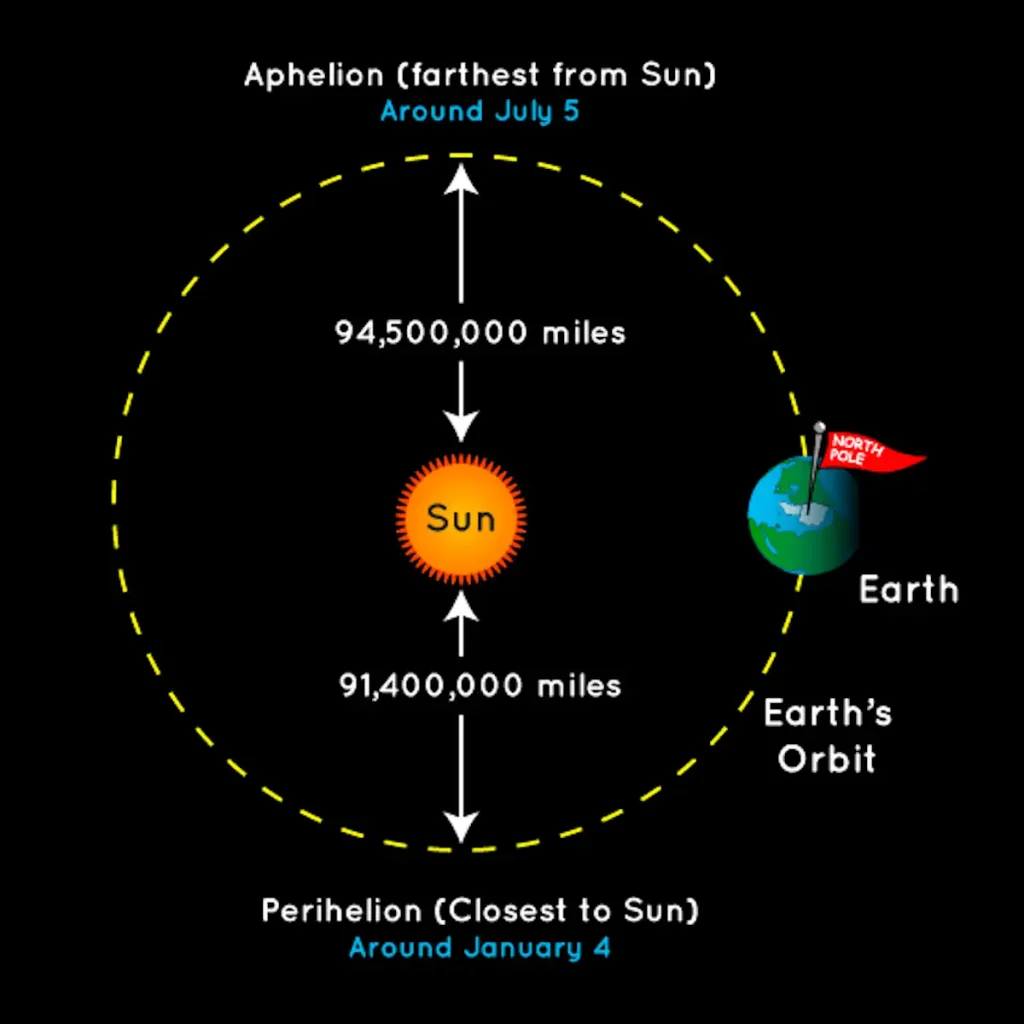The Earth’s journey around the Sun is not a perfectly circular orbit but rather an elliptical one. As a result, our planet experiences variations in its distance from the Sun throughout the year. Two significant events in the Earth’s orbit, known as perihelion and aphelion, mark its closest and farthest points from the Sun, respectively.
By examining the timing and implications of these occurrences, we can gain a deeper understanding of our planet’s relationship with the Sun. In this article, we will explore the Earth’s proximity to the Sun during perihelion, which occurs approximately two weeks after the December solstice, as well as its farthest distance during aphelion, which takes place approximately two weeks after the June solstice.
Perihelion: Earth’s Closest Approach to the Sun
Perihelion represents the point in the Earth’s orbit when it is closest to the Sun. This event occurs roughly two weeks after the December solstice, which marks the beginning of winter in the Northern Hemisphere and summer in the Southern Hemisphere.
During perihelion, the Earth is at its shortest distance from the Sun, resulting in increased gravitational pull and greater solar energy reception. However, it is important to note that despite being closest to the Sun during perihelion, the influence of Earth’s axial tilt still dominates the seasonal variations in temperature experienced on our planet.
Aphelion: Earth’s Farthest Distance from the Sun
Conversely, aphelion designates the point in the Earth’s orbit when it is farthest from the Sun. This event occurs approximately two weeks after the June solstice, which marks the onset of summer in the Northern Hemisphere and winter in the Southern Hemisphere. During aphelion, the Earth is at its greatest distance from the Sun, resulting in a weaker gravitational pull and reduced solar energy reception. Consequently, the solar radiation received during this period is slightly less intense compared to perihelion. Similar to perihelion, however, the primary factor influencing seasonal changes in temperature remains the Earth’s axial tilt.

Many people mistakenly believe that the Earth’s orbit -and the orbits of other planets- are strongly elliptical. However, this is not the case. The Earth’s orbit, like most planetary orbits, is nearly circular. This misconception likely arises from the way orbits are often depicted in textbooks and diagrams, typically shown from an oblique angle to save space. This perspective exaggerates the elliptical shape, as seen in images explaining Earth’s tilt and its role in creating seasons.
Perihelion and Aphelion dates, year by year
All aphelion (Earth’s farthest distance from the Sun) and perihelion (Earth’s closest approach to the Sun) times are given in local New York time.
2023
- Perihelion: January 4, 11:17. Distance: 147,098,925 km [91,403,034 miles]
- Aphelion: July 6, 16:06. Distance: 152,093,251 km [94,506,364 miles]
2024
- Perihelion: January 2, 19:38. Distance: 147,100,632 km [91,404,095 miles]
- Aphelion: July 5, 01:06. Distance: 152,099,968 km [94,510,538 miles]
2025
- Perihelion: January 4, 08:28. Distance: 147,103,686 km [91,405,993 miles]
- Aphelion: July 3, 15:54. Distance: 152,087,738 km [94,502,939 miles]
2026
- Perihelion: January 3, 12:15. Distance: 147,099,894 km [91,403,637 miles]
- Aphelion: July 6, 13:30. Distance: 152,087,774 km [94,502,961 miles]
2027
- Perihelion: January 2, 21:32. Distance: 147,099,894 km [91,406,556 miles]
- Aphelion: July 5, 01:05. Distance: 152,100,481 km [94,510,857 miles]
The Role of the Elliptical Orbit of the Earth
The elliptical shape of Earth’s orbit is responsible for the variations in distance between the Earth and the Sun during perihelion and aphelion. Unlike a perfect circle, an elliptical orbit causes the Earth to deviate from an average distance of approximately 150 million kilometers (93 million miles) from the Sun. The eccentricity of Earth’s orbit results in a difference of about 5 million kilometers (3 million miles) between perihelion and aphelion distances.
Impact on Seasons and Climate:
Although the Earth’s distance from the Sun during perihelion and aphelion has a minimal direct impact on the planet’s seasons, it does have subtle influences on climate patterns. The distribution of solar energy received during these orbital positions can slightly influence atmospheric dynamics and temperature gradients. However, it is essential to remember that the primary driver of seasons remains the tilt of the Earth’s axis.
The tilt of the Earth’s axis and its resultant effect on sunlight distribution play a fundamental role in creating the diverse seasons we experience. When a hemisphere is tilted towards the Sun, its rays strike the surface at a more direct angle, leading to increased solar energy and longer daylight hours. This results in warmer temperatures and the onset of summer.
Conversely, when a hemisphere is tilted away from the Sun, the sunlight arrives at a more oblique angle, leading to reduced solar energy and shorter daylight hours. This results in colder temperatures and the arrival of winter.
For example, the Earth is at its farthest point from the Sun when it’s summer in the northern hemisphere. Contrarily, it’s at its closest point to the Sun when it’s winter in the northern hemisphere.
Conclusion
The Earth’s proximity to the Sun fluctuates throughout its elliptical orbit, leading to perihelion and aphelion events. During perihelion, which occurs approximately two weeks after the December solstice, the Earth is closest to the Sun, resulting in increased gravitational pull and enhanced solar energy reception.
In contrast, aphelion takes place roughly two weeks after the June solstice, representing the Earth’s farthest point from the Sun, resulting in a weaker gravitational pull and reduced solar energy. While these variations in the distance have subtle influences on climate patterns, the primary determinant of seasons remains the Earth’s axial tilt.
Sources
- “Perihelion and Aphelion” on the Time and Date website
- How Many Elephants are Left in the World in 2025? - August 17, 2025
- Moon Landings: All-Time List [1966-2025] - February 2, 2025
- What Is Max-Q and Why Is It Important During Rocket Launches? - January 16, 2025

